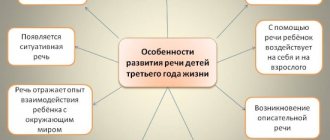Modern parents know that in order to successfully study at school, children need to clearly and clearly pronounce all the sounds of their native language. Without correct speech, it is impossible to express your thoughts, write dictations, or compose retellings. Usually, by school, a child should have well-developed speech. However, some preschoolers never learn to speak clearly and distort some sounds, so it becomes necessary to consult a speech therapist. Experts note that recently new types of dyslalia (sound pronunciation disorders) have appeared, which were almost never encountered before. These include incorrect pronunciation of the sounds T, D. Will parents be able to work on correcting sound pronunciation at home if such a speech disorder is discovered in a child? In order to properly organize classes at home, you need to understand what the production of the t sound is in connection with the production of the d sound.
Important: correct pronunciation develops mainly by the age of five, so you should seek special help after 5 years. However, from an early age it is necessary to carefully monitor the child’s speech, not to be touched by the distortion of words, but, if possible, to correct the child’s speech errors.
Features of articulation of the posterior lingual and types of disorders
When pronouncing K, the lips take the form of the subsequent vowel or half-smile, the teeth are open. The tip of the tongue is located at the bottom, and itself is shaped like a slide. The back of the backrest should touch the back of the roof of your mouth.
The lateral edges of the tongue should be pressed against the upper lateral teeth. When you say K, the vocal cords are not working, they are not closed. The exhalation must be strong in order to open the closure that forms between the back of the tongue and the palate.
The incorrect pronunciation of this sound is called cappacism, and its replacement with another is called paracappacism. There are several types of these violations:
- Instead of K, a guttural click is obtained. It is formed as a result of the fact that the vocal cords close, and during breathing there is additional pressure on them. When the child says K, the air comes out with a noise, which adds a guttural click.
- In speech there is a replacement with T.
- Replaces with X.
If there are any of these disturbances in speech, it is necessary to conduct a diagnosis and correct the sound pronunciation.
Reason 1. Individual pace
Of course, every child is unique and must develop on their own schedule. If your baby went a month earlier than your neighbor’s son, but said the word “mom” a few weeks later, there is nothing wrong with that. Everyone has their own pace.
This delay in speech development is called tempo. With a slight delay, everything will return to normal and the child will develop his ability to speak in the same way as all children.
Just pay attention that experts “allow” only a slight lag from the norm to be attributed to individuality. Be careful!
Reasons for violations
Children usually learn to pronounce correctly through onomatopoeia. But if there are deviations in the structure and operation of the articulatory apparatus, then the pronunciation of a certain sound group (or several) will be impaired. In the case of cappacism, this is an irregular shape of the hard palate, which causes difficulty in forming the bow necessary for correct articulation.
In addition, the cause may be weak or increased muscle tone of the tongue. Then the tongue cannot occupy or hold the desired position, which also affects pronunciation. The reason for the appearance of paracappacisms is the insufficient formation of phonetic-phonemic processes.
These types of sound pronunciation disorders may be signs of the following speech disorders:
- dyslalia - simple and complex forms;
- dysarthria;
- rhinolalia;
- alalia.
If there is a complex speech disorder, then it is necessary to provide comprehensive assistance, which includes not only sessions with a speech therapist, but also with a speech pathologist, and a consultation with a neurologist.
Tahilalia
With tachylalia, a pathological acceleration of the tempo is observed, while the child has normal hearing and no pathologies of the speech organs. Speech is fast, incomprehensible, the baby often swallows endings, distorts and repeats words, articulation is changed. Tachylalia is often associated with neurological disorders and can be manifested not only by an accelerated rate of speech, namely:
- the child stammers, swallows words;
- he doesn't have enough air to say the next words;
- moves fussily and quickly;
- has trouble falling asleep, often wakes up;
- there are problems with memory, reading, writing;
- often gets irritated and behaves aggressively;
- has difficulty concentrating on a task;
- attention is scattered.
Children with tachylalia talk non-stop, they do not listen and interrupt their interlocutor, and therefore they have problems communicating with peers and adults.
In some cases, tachylalia is caused by a hereditary predisposition, but often this disorder is explained by damage to the central nervous system due to severe infections, injuries, and certain diseases.
Diagnosis and treatment of tachylalia occurs with the participation of a speech therapist, neurologist and psychologist. If time is not lost, then the overall prognosis is favorable. Tachylalia may return within a year after correction. The most lasting results are provided by group classes with an experienced speech therapist.
Diagnostics of sound pronunciation
The speech therapist evaluates sound pronunciation, looks at the state of the articulatory apparatus and phonemic processes. First, the specialist studies the anatomical structure of the articulation organs, then evaluates their work. To do this, the speech therapist asks to perform exercises to maintain a certain position, gives tasks for motor skills (raise and lower the tongue, show the horse, etc.).
Then the specialist asks the child to say the desired sound. First, he pronounces it without combination with other sounds, in syllables with vowels and other consonants. Then in words, phrases, sentences, coherent speech. In tasks for assessing coherent speech, you need to compose a story based on a picture, talk about your favorite toy or cartoon, or on any other topic.
The purpose of tasks for phonetic-phonemic perception is whether the child distinguishes K in the speech stream and does not confuse it with sounds similar in acoustic characteristics. The speech therapist pronounces different sounds, the child needs to select the one he needs. Then the material is complicated - they pronounce it in words, syllables. An adult can ask you to name all the objects that contain K. A good task is to distribute the pictures into groups for a specific sound.
The specialist pays attention to the speech environment in which the child grows up. If one of the adults around him has kappacism or parakappacism, then either he also needs to correct his pronunciation, or try to use fewer words with the sound K when communicating with the baby.
Reason 4. Bilingual family
Bilingual children “have the right” to begin to speak with some lag behind the norm. Hearing different languages spoken around them, they find themselves in a more difficult situation than their peers who only need to master one language.
In order to correctly construct speech, a child needs to separate one language from another. This requires some time. So it is quite possible that there is a delay in the onset of speech formation, the absence of common sentences, and errors in the grammatical construction of phrases.
Staging methods
The easiest way to stage it at home is by onomatopoeia. To do this, ask your child to cough (cough). You should open your mouth wide so that your baby can see the correct articulation. You need to cough with a small exhalation so that there is no pronounced X between K and E.
Then offer to cough in a whisper. This will help remove the X sound, the result should be the syllable KE. Practice this syllable, then invite your child to combine it with other vowels. Try speaking the sound in isolation.
But the onomatopoeic method does not always help in cases of complex speech disorders. For such options, there are other ways to set the back-lingual group of sounds:
- Staging while inhaling. The adult asks to hide the tongue as far as possible. Be sure to show your child how to do this. With this inhalation, you need to pronounce syllables like KA. After practicing, make the task more difficult: inhale like this, and say this syllable as you exhale. When the back-lingual sound becomes clear, practice its pronunciation in isolation.
- Mechanical method. For this you need a speech therapy spatula. Ask your baby to pronounce the syllables TA-TA-TA. You press the tip of your tongue with the spatula and gently push it deep into your mouth. Before doing this, be sure to warn your child about what you will do and ask him not to remove his tongue. When you hear a clear K, focus your baby’s attention on its sound. Let the child try to pronounce it without the help of an adult. Of course, he may not be able to immediately pronounce it on his own, and an adult will need to help him. When the child learns to say it on his own, begin to consolidate it in syllables.
These were ways to make the K sound yourself at home. Most often, it can be delivered using onomatopoeia, because the articulation of the back-linguals has the same base. And if a child has one of the sounds of this group, then he will quite easily learn the articulation of other back-lingual sounds.
Parents ask a speech therapist: “The child cannot pronounce the letter K, how can he quickly learn correct articulation?” First, the speech therapist sets up sounds and letters are taught in literacy classes. Secondly, the duration of correctional work depends on the speech disorder and the individual characteristics of the child.
Why can't my child pronounce the letter "k"?
A common reason that a child does not say the letter “k” is that parents and other close relatives coo with him, that is, they imitate his undeveloped speech skills. An adult's speech drops to the level of a child's speech. A child, without hearing normally pronounced sounds and letters around him, cannot learn how to pronounce them correctly. In order for the baby to learn to speak correctly, the parents’ speech must be clear and understandable.
Other reasons that prevent a child from correctly pronouncing a particular sound, in particular “k,” are as follows:
- Pathologies of the hearing aid or visual organs.
- Too big or small tongue.
- A short ligament located under the tongue.
- Paresis of the root of the tongue.
- Thin or thick lips that interfere with normal articulation.
- Irregular structure of teeth or jaw.
- Hypotonicity of the root of the tongue.
- Rhinolalia (splitting of the hard and soft palate).
- Gothic, slit-like or narrow structure of the palate.
Recommendations for parents on automation and differentiation
Once you have established the correct pronunciation, you need to reinforce it in your speech. You need to start working on automation with something simple - with syllables, gradually complicating the speech material to compiling stories and retellings. If, in addition to cappacism, the child has paracappacism, then when choosing words for reinforcement, be careful: the words should not contain sounds that are similar in acoustic characteristics.
The child says T instead of K - this is one of the most common forms of paracapacism. In general, replacing one sound with another may be due to the absence of one of them. At the differentiation stage, be sure to talk through the articulation of mixed sounds with your child and focus on their differences.
To differentiate, start with isolated pronunciation. When the child can accurately identify the desired sound, complicate the speech material. But the mixed sounds must be in a strong position so that the child can hear them clearly. This stage needs to be worked out only when the child’s sound pronunciation is corrected and the stage of automation in syllables and words is underway, then the correction work will be effective.
Production of sounds T - D when replaced with back-lingual K - Gplan summary on the topic
Production of sounds T - D when replaced with back-lingual K G
Our speech consists of sounds. A child must learn to correctly pronounce the sounds of his native language before school. In preschool age, the child’s pronunciation of sounds is observed incorrectly. This is a completely natural phenomenon. Three- to four-year-old children are characterized by a general immaturity of language. If you are not attentive to the child’s sound pronunciation, then such substitutions and distortions of sounds can remain for a long time.
For successful learning, a child needs intelligible and clear sound pronunciation. However, a large number of first-graders come to school with impaired or distorted sound pronunciation.
Experts note that recently a new type of dyslalia has appeared - incorrect pronunciation of sounds T - D. These anterior lingual sounds appear in ontogenesis at the age of 3 - 4 years.
When pronouncing these sounds, children make typical mistakes:
- Replacing the front-lingual sounds “T – D” with the corresponding back-lingual “K – G”, for example, “fuk(t)bolka”, “shk(t)ana”.
- Mixing the front-lingual consonants “T – D” with the back-lingual “K – G”: cell - cell; glass - rolled.
- The sound “T” can be softened by “P” or “K”, for example: pichka - bird; drink, drink instead of dot.
Reasons for incorrect sound pronunciation:
- Insufficient development of the articulatory apparatus.
- Violation of muscle tone of articulatory muscles.
- Underdevelopment of auditory perception (difficulty in differentiating sounds).
Articulatory structure of the T sound.
The sound T is front-lingual, consonant, hard, deaf. The sound D is anterior lingual, consonant, hard, voiced.
- The lips in a neutral position take the position of the next vowel sound,
- The distance between the teeth is 5 mm.
- When pronouncing the vowel sounds A, O, U, Y, the tip of the tongue rests on the upper teeth or alveoli and forms a stop.
- The soft palate is raised, the vocal folds are open, the air stream is jerky
Features of sound production T - D
The classic techniques of speech therapy work are the preparatory stage and sound production.
1.Preparatory stage
Articulation gymnastics.
Speech therapy massage will help prepare the speech apparatus for it.
- “Wide smile” – connect your teeth, stretch your lips wide and hold this position for up to 7 seconds
- “Naughty Tongue” - say five-five-five, tapping your upper lip on your tongue, gradually differentiating (distinguishing) the sounds P-T.
- “Pancake” - relax the tongue, making it wide, and place it on the relaxed lower lip.
- “Rock” - raise the tongue only to the upper lip. We increase the rise of the tongue.
- “Grandfather’s mustache” - hold the cotton swab with your tongue on (above) your upper lip.
- “Sail” - a narrow tongue rests on the upper teeth - mast, raise the sail - a wide tongue. Alternation of narrow and wide language.
Exercise to form correct directed exhalation
- Blow out the candle - the child must purse his lips into a tube and sharply blow on the candle flame and extinguish it.
- Let's kick the ball into the goal. The child makes a gate out of bricks, places it in front of him, rolls a ball out of cotton wool and, smiling, blows hard on the ball, trying to get into the gate.
- “Snowflake” - the cotton wool is placed over the upper lip, the tongue covers the upper lip - inhale and exhale on the cotton wool.
The breathing exercise “Snowflake”, exercises for the tongue “Grandfather’s mustache”, “Rock”, “Sail” are quite effective in cases where the child has increased muscle tone of the tongue, and he cannot hold it near the teeth when exhaling.
2. Setting the sound T.
- Demonstration of correct lip and tongue position by showing
distinctions in pronunciation, for example, T (tip of the tongue) and K (tail of the tongue): “The cake is being eaten,” “Drops are dripping.”
- Imitation setting: an adult shows the position of the tongue and suggests repeating first the syllables and then the words.
- Interdental. The speech therapist asks the child to smile, bite the tip of his tongue with his teeth, and forcefully, sharply push the air forward. In this case, you can control the exhalation with your hand or blow on a cotton ball.
- Setting T from the sound P. The child repeats pa-pa-pa, placing the wide tip of the tongue on the lower lip, then, smiling broadly, pronounces P, which turns out to be T.
- Setting from Ts. I propose this technique from the opposite: the sound Ts “hides” two sounds behind itself - s-t.
“The cat catches the mouse” - we invite the child to imitate the movement of the cat’s claws with his fingers, straining his fingers and saying: tsap, tsap, tsap.
Then we shorten the syllable - tsa, tsa, tsa.
And here we are near the mink - we say Ts, Ts, Ts more and more quietly. Here you need to ask the child to only hit the teeth with the tongue - the T sound, do not pronounce the C sound.
- When setting D, the work is identical, only when exhaling the voice is added.
Automation of sounds T D
The sound is on. The beginning of a new stage: automation. All work on automation and differentiation of the studied sound consists of developing the skills of recognition and correct pronunciation of sound in syllables, words and sentences. It is important to achieve free pronunciation, while not forgetting about articulatory gymnastics.
The correct selection of articulatory and breathing exercises, exercises, and verbal material will help to obtain good results in the development of competent, beautiful speech in a child.
This is a long, labor-intensive process that requires patience and hard training. With systematic and regular work on the sounds T and D, it is possible to achieve positive results, i.e. create sounds, automate them and introduce them into the child’s speech.
Exercises for pronouncing sounds
Initially, it is recommended to prepare cards that will depict animals and objects that have problematic letters at the beginning, middle or end. You need to observe whether the pronunciation of a complex letter always turns out to be problematic, or in some positions.
1. To master the letter “C”, it is recommended to use the following exercises:
- “Rails” (when the tongue must “ride” along the inside of the upper teeth).
- “Silence” (repeat the sound “t-sss” several times, stretching the letter “S”).
To reinforce the letter, you need to choose pictures or words where the letter “C” is present: sleigh, sieve, belt, sun, light. You can use sentences: Sasha sows seeds or poems:
"It's dark in the forest,
Everyone has been sleeping for a long time.
One owl doesn't sleep
She’s sitting on a branch.”
2. The letter “Z” is a brother of “S”, only voiced. Therefore, to teach a child to pronounce the letter “Z”, you need to pronounce “s” only by raising your voice. Show your baby by raising your hand to his throat how the muscles tense, making ringing sounds. We fix the letter with words: hare, animal, tooth, star, as well as sentences: A bunny in winter is like a small animal.
3. The letter “C” can be mastered by resorting to the “Silence” exercise, only you need to pronounce not “t-sss”, but “ts-ts-ts”. We fix it with words: heron, chicken, chain, pizza, and sentences: What color is the bird?
4. You can pronounce the letter “Ш” using a little trick: ask the child to pronounce the letter “s”, and use a spoon to lift the baby’s tongue to the sky. The sound will be “sh”. The letter is fixed with the words: awl, whisper, ears, noise; sentences: Our Masha rustles; and also in verse:
“Dear bear, Nice bear, Our bear is all made of plush.”
5. The same trick can be done with the letters “z” and “z”. fix the letter “F” with the words: beetle, hedgehog, toad. And also in sentences: Zhanna is waiting for a book.
6. To master the letter “Ch” , ask your baby to say “t-t-t” while pressing the baby’s cheeks with your fingers. Then you will hear the cherished “h”. To reinforce the letter, ask your child to say the words: tea, turtle, daughter, ball; suggestions: Clean the siskin's bathtub.
7. The most common problem for parents is the problem of the letters “R” and “L”. Techniques and exercises for solving this problem are aimed at teaching the child to growl without swallowing complex letters and without replacing the complex “r” with the easier “l”:
“Horse” - together with your child, imitate the clicking and clattering of a horse’s hooves.
“Brush your teeth with your tongue” - ask your baby to smile widely. Then you need to run your tongue along the inner surface of the upper teeth. Make sure that the child's lower jaw remains motionless.
“Tease” - the child is invited to tease. To do this, the relaxed tongue sticks out and dangles up and down. The teasing is accompanied by a growl.
Special attention in teaching the letters “P” or “L” is paid to tongue twisters:
- The Greek was driving across the river, he saw the Greek: there was cancer in the river.
- There is grass in the yard, there is firewood on the grass: one, two, three there is firewood.
- The brave man ate thirty-three pies, all of them with cottage cheese.
- You can’t say all the tongue twisters quickly.










